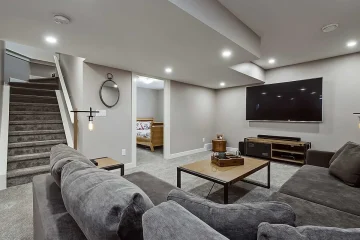Revamping your home’s interior with paint is more than just a change of color—it’s a transformative process that can address and overcome various design challenges. Whether you’re dealing with cramped spaces, lack of natural light, or simply want to refresh the look of your home, strategic use of paint can make a significant difference. This article delves into tailored strategies for a variety of common design challenges, offering insights and tips to help you achieve your desired aesthetic.
Understanding the Impact of Color
The initial phase of any home painting or roof painting project involves recognizing color’s impact. Warm shades such as red, orange, and yellow craft a welcoming ambiance, whereas cool tones like blue, green, and purple inspire tranquility. Neutral hues provide versatility, serving as a foundation for bolder accents. This understanding is crucial, influencing mood, spatial perception, and even the perceived temperature of a space.
Maximizing Natural Light
For rooms that suffer from a lack of natural light, choosing the right paint color can make all the difference. Light and bright colors like white, cream, or pale yellow can reflect light, making a room feel more colorful and more open. Consider a paint with a satin or semi-gloss finish to maximize the light-reflecting properties.
Creating the Illusion of Space
Small rooms can feel more spacious with the right paint strategies. Opt for light, cool colors to make walls appear to recede, giving the illusion of more space. Painting the ceiling a lighter color than the walls can also make the room feel taller, adding to the sense of openness.
Addressing Room Proportions
Rooms with awkward proportions can benefit from strategic color choices. Painting one or two walls a darker shade can help balance the proportions of a room, making it feel more harmonious. For example, in a long, narrow room, painting the shorter end walls a darker color can make the room appear more square.
Warming Up Cold Spaces
Consider using warm paint colors to add warmth to a space that feels cold or impersonal. Shades of red, orange, or even a warm white can transform the atmosphere of a room, making it feel more inviting. Textured finishes can also add warmth and character to a space.
Creating Focal Points
Paint can be used to create or highlight focal points in a room. Choose a bold color or an interesting texture for one wall to draw attention to a specific area, such as a fireplace or an art collection. This not only adds interest but can also help to define the space.
Unifying Disjointed Spaces
In homes with open floor plans or disjointed layouts, paint can help create a sense of cohesion. Using different shades of the same color can delineate spaces while maintaining a unified look throughout the home. This strategy can also be used to link rooms in a more traditional layout.
Concealing Imperfections
Paint can also be used to conceal imperfections in walls. Matte finishes can help hide blemishes by diffusing light, while textured paints can cover up minor cracks and irregularities. However, it’s important to properly prepare the surface before painting to achieve the best results.
Selecting the Right Finish
The finish of your paint can have a big impact on the overall look and feel of a room. Matte finishes offer a soft, velvety look but can be less durable, while gloss finishes are easy to clean but can highlight imperfections. Eggshell and satin finishes provide a middle ground, offering some sheen without the drawbacks of higher gloss finishes.
Experimenting with Color Schemes
Don’t be afraid to experiment with different color schemes. Monochromatic schemes, using various shades of the same color, can create a subtle and elegant look. Complementary schemes, which use colors opposite each other on the color wheel, can add dynamic contrast to a space. Analogous color schemes, which use colors that are next to each other on the color wheel, can create a harmonious and cohesive look.
Implementing Your Vision
Once you’ve selected your colors and finishes, proper preparation is key to achieving a professional-looking result. Clean and repair walls as needed, and use primer to ensure a smooth, even base. Test your colors in different lights to see how they change throughout the day, and use quality tools and paints to ensure the best finish.
Conclusion
Paint is a powerful tool for transforming your home, offering endless possibilities for enhancing both its appearance and functionality. By understanding the principles of color psychology, choosing the right shades and finishes, and employing strategic painting techniques, you can overcome a wide range of design challenges.
Whether you’re looking to brighten a dark room, make a small space feel larger, or simply refresh your home’s look, the right paint strategy can help you achieve your goals. Remember, the most important aspect of any home upgrade is that it reflects your style and makes you feel comfortable and happy in your space. With careful planning and a bit of creativity, you can use paint to create a home that you love.




